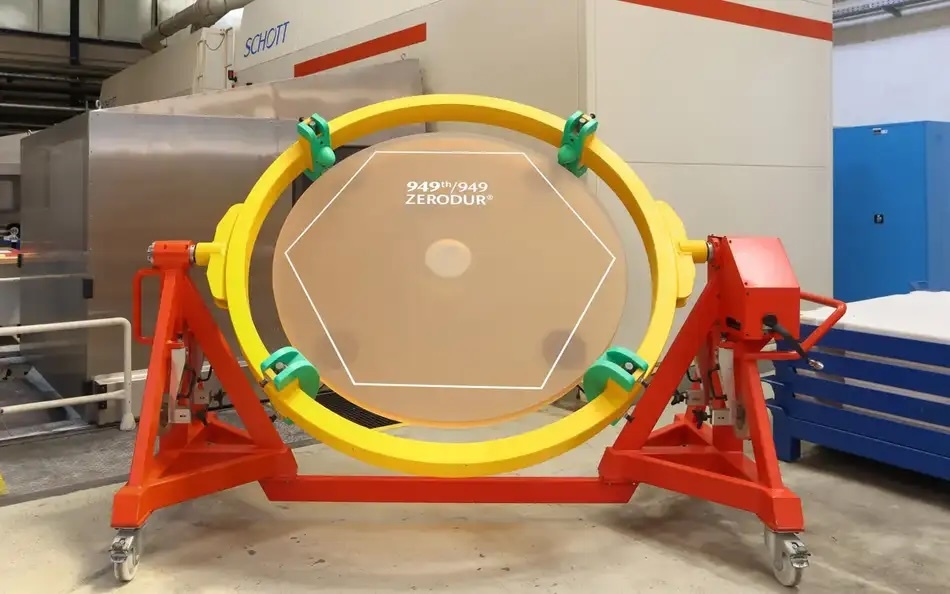1.07.2024
- SCHOTT successfully wrapped up its ZERODUR® glass-ceramic series production for the European Southern Observatory’s (ESO) Extremely Large Telescope (ELT) primary mirror.
- The specialty glass manufacturer produced a total of 949 mirror blanks what will be the world’s largest optical/infrared telescope mirror.
- Due to its near-zero coefficient of thermal expansion, ZERODUR® provides the ELT’s optics with thermal stability despite the extreme temperature fluctuations at its site in Chile’s Atacama Desert.

SCHOTT produced its final mirror substrates for the ELT’s main mirror. Photo: SCHOTT
SCHOTT has successfully shipped its final segment blanks for the Extremely Large Telescope’s main mirror, made from its glass-ceramic ZERODUR®. At 39 meters in diameter, the ELT’s segmented M1 mirror will be the largest optical telescope mirror ever built. As part of this megaproject, the company manufactured its ZERODUR® glass-ceramic mirror substrates at its headquarters in Mainz, Germany in a production spanning six years, including four years of serial production. Previously, SCHOTT also produced the mirror substrates for the ELT’s M2, M3, and M4 mirrors.
Currently under construction in Chile’s Atacama Desert, the European Southern Observatory’s Extremely Large Telescope will be the world’s largest optical telescope when it sees its first light in 2028. In the planning for over 25 years and under construction for ten years, the ELT is a 1.45 billion euro megaproject made possible by a strong international collaboration. Its 39 m main mirror is too large to be made from a single piece of glass, so it will consist of 798 hexagonal segments made of SCHOTT’s ZERODUR®, each about 5 cm thick and 1.5 m in diameter. After their production in Mainz, the M1 mirror blanks have a long journey to the ELT’s site in Chile. After they are polished by French company Safran Reosc, the segments are then shipped over 10,000 km to ESO’s facility at Paranal Observatory in the Atacama Desert, where they are coated with a silver layer to become reflective.
SCHOTT and ESO: partners in innovation
After a successful production for ESO’s Very Large Telescope in the 1990s, ESO turned to SCHOTT to help make their ELT megaproject a reality. In a close collaboration with ESO, SCHOTT began its ZERODUR® production for the ELT 9 years ago, delivering its ZERODUR® mirror substrates for the 2.4 m M4 (which is the largest adaptive mirror ever built), the convex 4.2 m M2 (the largest optical secondary mirror ever used), and the concave 4 m M3. In 2017, ESO awarded SCHOTT the contract to produce 949 mirror substrates (798 mirror segments plus 133 spare segment blanks and 18 validation blanks) for its M1 primary mirror, in what is the largest single order of ZERODUR® in SCHOTT’s history. The company delivered its initial 18 validations blanks in July 2019, and started its serial production at the end of the year. This production involved a dedicated team of around 100 people across processing, logistics, quality, melting, annealing, ceramization, quality management, supply chain management, engineering, construction, and product management, among others. Thomas Werner, the ELT Project Lead at SCHOTT, says: “This project has been a huge undertaking at SCHOTT, which is why we are so proud to successfully conclude our ELT M1 series production successfully. It’s been an honor for us to contribute to the future of astronomy and we’re excited to see what discoveries ESO’s ELT will bring us.”
ZERODUR®: extreme precision for astronomy and industry
To deliver incredibly high-resolution images of distant objects, large telescopes require thermal stability for their optics. ZERODUR®’s near-zero coefficient of thermal expansion means that it does not shrink or expand with temperature changes: as a mirror substrate material, it provides the ELT’s optics with incredible precision despite temperature fluctuations. The M1 glass-ceramic mirror substrates also feature single-digit ppb/K CTE homogeneity across the entire volume of each substrate.
SCHOTT developed its production capacity necessary for the ELT project through its experience producing large quantities of ZERODUR® for industrial applications like IC lithography, aviation, metrology, and space. These industrial applications have increased the demand for ZERODUR® significantly, and constitute the majority of SCHOTT’s production. SCHOTT has accordingly substantially increased its ZERODUR® production capacity to meet current and future demand.
Quelle: SCHOTT
